Managing creative projects is different from traditional project management in many ways:
- For starters, creative projects involve many elements — teams are responsible for designing marketing and sales collateral, commercials and other video promotions, website elements, etc., and they often work with in-progress design files and other media types.
- Creative projects typically involve many collaborators — designers, marketers, managers, freelancers, clients, and other stakeholders — all of whom can have different opinions and perspectives.
- On that note, creative projects often have multiple feedback loops. Content for projects is rarely approved in the first round. Feedback may be more exploratory, teams may test different versions of content, and they have to keep track of file versions along the way. Seeing how content evolves through revisions can be crucial to strategizing for future projects and streamlining processes.
- Lastly, in addition to tasks and content for projects, creatives and marketers need to track project resources and costs so they can report on profitability and show the value of their work.
Therefore, creative teams require unique processes and solutions to manage projects, people, content, and costs.
We’ve been working with creatives and marketers for 20+ years to help them refine their processes and manage workflows more efficiently. We designed Workamajig — our creative workflow management solution — based on our experience and everything we’ve learned.
We put together this guide to review the best practices for managing the creative workflow and discuss the best software solutions for creatives and marketers.
How Do You Implement a Creative Workflow?
Marketing teams, designers, advertising agencies, and content agencies all have slightly different workflows. But generally, the creative workflow includes six key phases:
- Definition — this is where you define the project scope or build a creative brief with the client or person requesting work. What’s the desired end product? What goals are you trying to achieve?
- Scheduling — this is where you plan project resources and timelines. You decide on budgets, assign roles and responsibilities, plan milestones, and more.
- Creation — this is where teams work through tasks and design different types of content for review.
- Review & feedback — this is where project teams collaborate and incorporate clients to achieve the desired result.
- Project approval & launch — this is where you send off final deliverables or launch campaigns.
- Analysis — this is where you report on the overall “success” of the project. Did you deliver as promised (a desired end product on time and within budget)? If not, where did your plans go off course? Where can you optimize processes for next time?
Best Practices for Managing Creative Workflows
Our first and arguably most important recommendation is to centralize project and workflow management efforts — that’s because the majority of problems we see teams face stem from managing different elements of creative work with different tools.
For example, we see creative teams:
- Manage project schedules and tasks in their project management tool.
- Store content for projects using digital asset management software or another cloud storage solution like Dropbox.
- Communicate with clients and freelancers — and manage those relationships — over email or messaging apps like Slack.
- Reference employee schedules and log project hours in a time-tracking tool.
- Create project invoices, manage billing, and monitor revenue in accounting software.
- Use business analytics tools to report on project ROI and success.
However, none of these systems work together; teams have to hop between platforms, and aggregating data in real-time is an ongoing, time-consuming challenge. These disparate systems also make it nearly impossible to pull accurate, comprehensive data.
They might assign tasks to an out-of-office employee and then have to reorient, delaying projects. Or they might bog down one employee while another sits bored.
Project details are lost in communications, and visibility into conversations is limited, so other team members can’t double-check each other. Then they’re redoing work (wasting time and frustrating clients in the process).
It’s typically not until projects wrap that teams realize they allocated too many hours to a service or see costs outweigh revenue, and they don’t make a profit for their efforts. Plus, without project-level financials incorporating overhead, they never see real profitability. Typically, teams import top-level project financials into the accounting software & manually enter invoices, but then they're missing so much of the picture.
By centralizing efforts, you can bring everyone under the same roof and manage all the steps and elements of creative workflows in one system. This is also beneficial because:
- Most creative workflow management systems have automation tools to streamline workflows and save time on repetitive tasks (like building and sending invoices).
- It provides all stakeholders visibility into the project workflow — managers can monitor project progress without hunting for the right email or Slack thread, and clients can check in without emails.
- This visibility allows for clearer collaboration between project teams and clients. Designers can upload content into the system, and then clients can join feedback discussions early on and quickly access final deliverables (helping to speed up this process and simplify file sharing).
- It improves portfolio management. You can access past projects, creative assets, and all project details, including true profitability by project or client, and then use those insights to guide your strategies.
- Lastly, and also very important, having a single source of truth to manage creative projects allows teams to incorporate tasks like time and budget tracking into workflows and see real-time data. Since all systems work in sync, teams can easily ensure projects stay on schedule and don’t exceed planned budgets or timelines.
This last point — tracking project costs within the workflow — is a critical best practice to track profitability, obtain agency-level analytics, optimize resource allocation, and increase ROI from work.
We suggest:
- Sourcing freelancers and planning other project resources (like media buys) upfront so you can incorporate those costs into estimates.
- Budgeting a certain number of hours for projects and tracking hours as you go.
- Tying employees’ hourly rates with hours to see all project costs as you work.
We wrote a guide on this that you can read here: How to Track Creative Project Management Hours
|
|
Workamajig’s System to Manage Creative Workflows
As mentioned, Workamajig is an all-in-one solution for creatives and marketers specifically designed for the nuances and complexities of a creative team's workflow — from project requests through launch, invoicing, and profitability reporting.
Our solution is described as a creative workflow management system. Still, it is also categorized as an agency management tool because it includes a robust toolset for managing projects, resources, and finances. We support the creative processes of both in-house teams and agencies at all growth stages.
Our platform includes:
- Project management — project request management, project planning, and project monitoring
- Resource management
- Vendor management
- Client management
- Time tracking
- Accounting software (to replace QuickBooks, Xero, Sage, and other accounting systems)
- Financial reporting
We’ll further illustrate the creative workflow below and show you how our system supports these steps.
To learn more about our creative workflow best practices, you can always request a personalized demo of Workamajig.
Managing Project Requests & New Opportunities
First, our system lets you manage new project requests in a few ways.
You can create project intake forms (with custom fields to gather essential details at the first communication) and paste these on your website or in user portals for others to request work 24/7. Managers can review these requests, approve or deny them, and begin planning the details.
You can also create project templates customized to your workflows to kick off familiar projects. For example, if your agency offers a logo design service, you could make a project template that automatically adds details, time allotments, tasks, services, and users to streamline planning.
Workamajig also includes a native CRM for managing new sales opportunities. Leads who submit website contact forms or email your team automatically populate this dashboard, making it easy for sales teams to field these opportunities. Our CRM also includes Kanban boards to visualize leads through the pipeline.
.gif?width=906&height=510&name=gif%202%20(4).gif)
Finally, Workamajig converts approved requests and closed opportunities into active projects, automatically saving all details and attachments from request forms and sales conversations so project teams have the full context.
Planning New Projects
Workamajig lets you plan all project details so you can send accurate estimates and timelines from the get-go — keeping requesters happy and ensuring project profitability.
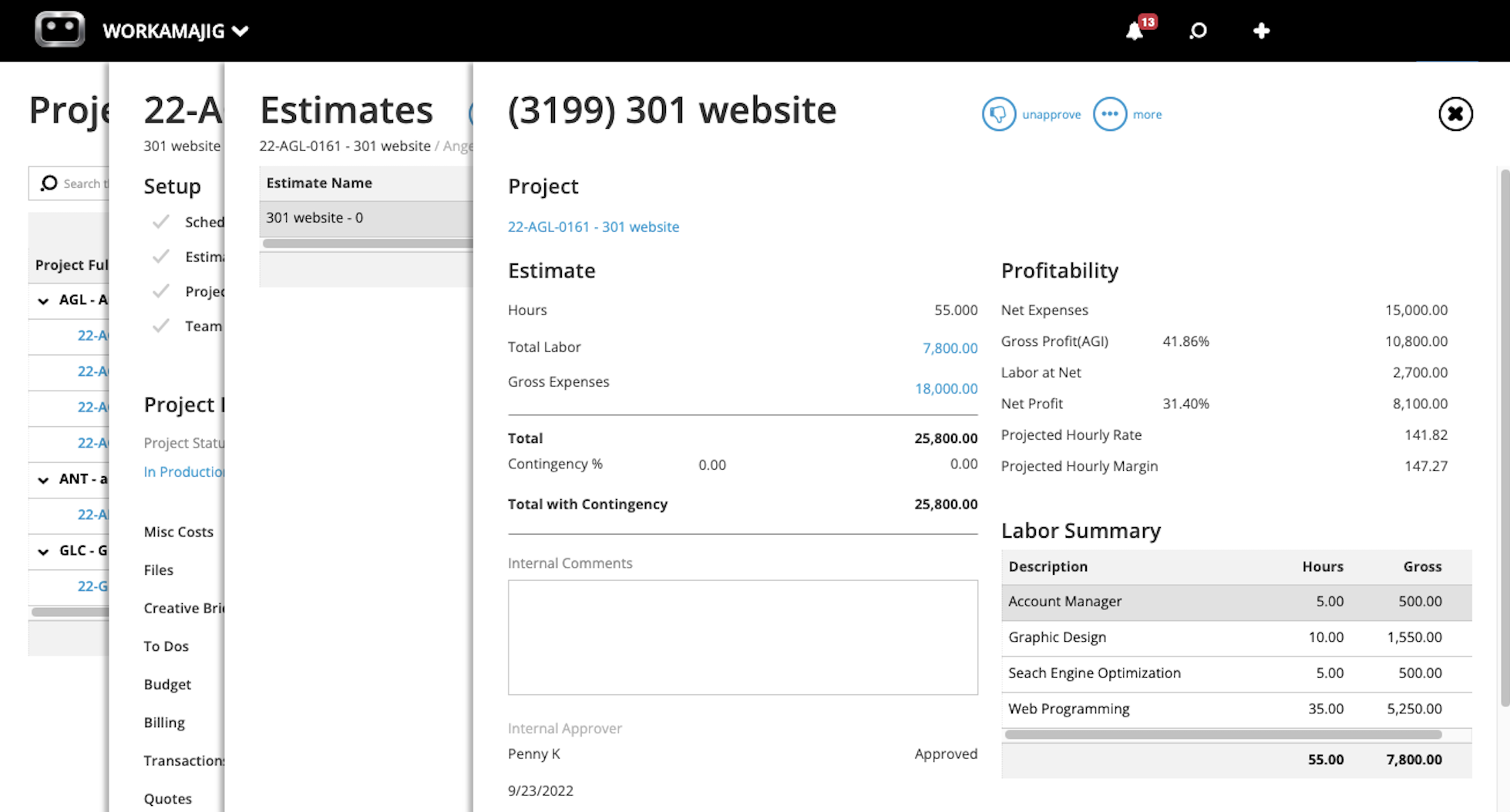
You can plan:
- The tasks needed to complete projects.
- The resources needed for projects — including staff members, freelancers, media, and other expenses.
- Budgets and timelines.
Task Management
For teams to understand the scope and expectations for each project, you can easily build out all of the tasks needed to complete projects, including any necessary details. Here is where you allot time for tasks, too.
You shouldn’t allocate all budgeted hours for tasks in the first assignment. As mentioned earlier, most content requires rounds of reviews and revisions, so you want to plan for that time; otherwise, projects can run over schedule and/or exceed budgets.
Allocate a few hours for the initial design, then plan time for the review process.
.gif?width=906&height=447&name=GIF%201%20(1).gif)
Resource Management
You can assign team members to tasks and see the costs for your employees’ work.
Our resource management dashboard displays your entire lineup and each staff member’s total bandwidth. You can also see the number of hours they’re currently scheduled (with a breakdown by day) and how many hours remain.
Then, you can assign the right person(s) for projects and balance employee workloads.

All employee hours are tied to rates, so you can monitor project costs as you assign employees to tasks and as they log hours. This improves resource allocation and helps you strategically re-assign to keep projects on course.
Workamajig also integrates with calendar systems to show when employees are available. You can see when employees are out of the office or tied up in other meetings or work obligations; then, you can schedule employees for tasks when they’re free, which keeps your team members happy and projects on schedule.
Note: This integration is also valuable for tying meeting hours to projects and invoicing for all billable work. Calendar events populate Workamajig, and employees can easily confirm they attended and specify which project the meeting relates to.
.gif?width=906&height=459&name=GIF%204%20(2).gif)
Vendor Management
Workamajig also lets you source freelancers for projects and supports those relationships. You can:
- Request quotes for work.
- Review bids and assign tasks.
- Create unlimited vendor portals to manage and organize communications.
- Receive and reconcile vendor invoices.
- Send payments and track payment history.
Workamajig Integrations
Our system also integrates with media planning tools like Strata and fintech software like Plaid and FastPay to aggregate other project expenses.
For example, Strata lets you plan media buys and pull data from insertion orders. Plaid lets you connect with credit card systems to automatically import and track project-related charges. Then, you can incorporate these costs into estimates and invoices.
You can also view our entire list of integrations here.
Monitoring Project Health
After projects are planned and kicked off, you can monitor their status and “health” in the Projects dashboard.
Project Monitoring
The Projects dashboard displays customizable Gantt charts to visualize project progress. You can split projects into phases and assign a color to each phase, making it easy to see where they stand.
.gif?width=906&height=451&name=GIF%203%20(6).gif)
Our system shows you which projects to focus on with Finance and Project Timeline warnings.
In the clip above, take notice of the data on the left-hand side. This breakdown displays yellow warnings in the Finance, Project Timeline, or % Complete columns when projects risk exceeding budgets or due dates. (Our system also sends you notifications about at-risk projects.) Then, these warnings turn red after projects have exceeded costs or missed due dates.
For example, the ANT SF website project (above) shows a red warning in the Project Timeline column and the % Complete status bar, indicating that the project ran over the expected timeline.
Time Tracking
Our system includes native time tracking, so you can track project hours, and we can display real-time progress in our Projects dashboard.
This dashboard updates as users mark tasks completed, showing real-time costs and expected due dates. For example, are tasks finished on time, or are they days late (and how does that push you back)?
We include time-tracking features on task cards so employees can efficiently use this best practice in their workflow.
We provide multiple options for time tracking:
- Users can manually add hours as they mark tasks complete.
- Users can utilize timers to track real-time progress and report hours down to the minute. Managers can see that employees are working on tasks and how long they’ve spent; employees can toggle between tasks and pause timers as they switch. Then, they mark tasks complete to report hours and update the dashboard.
- Employees can add time from calendar events. This gives managers a full view of project completion times.
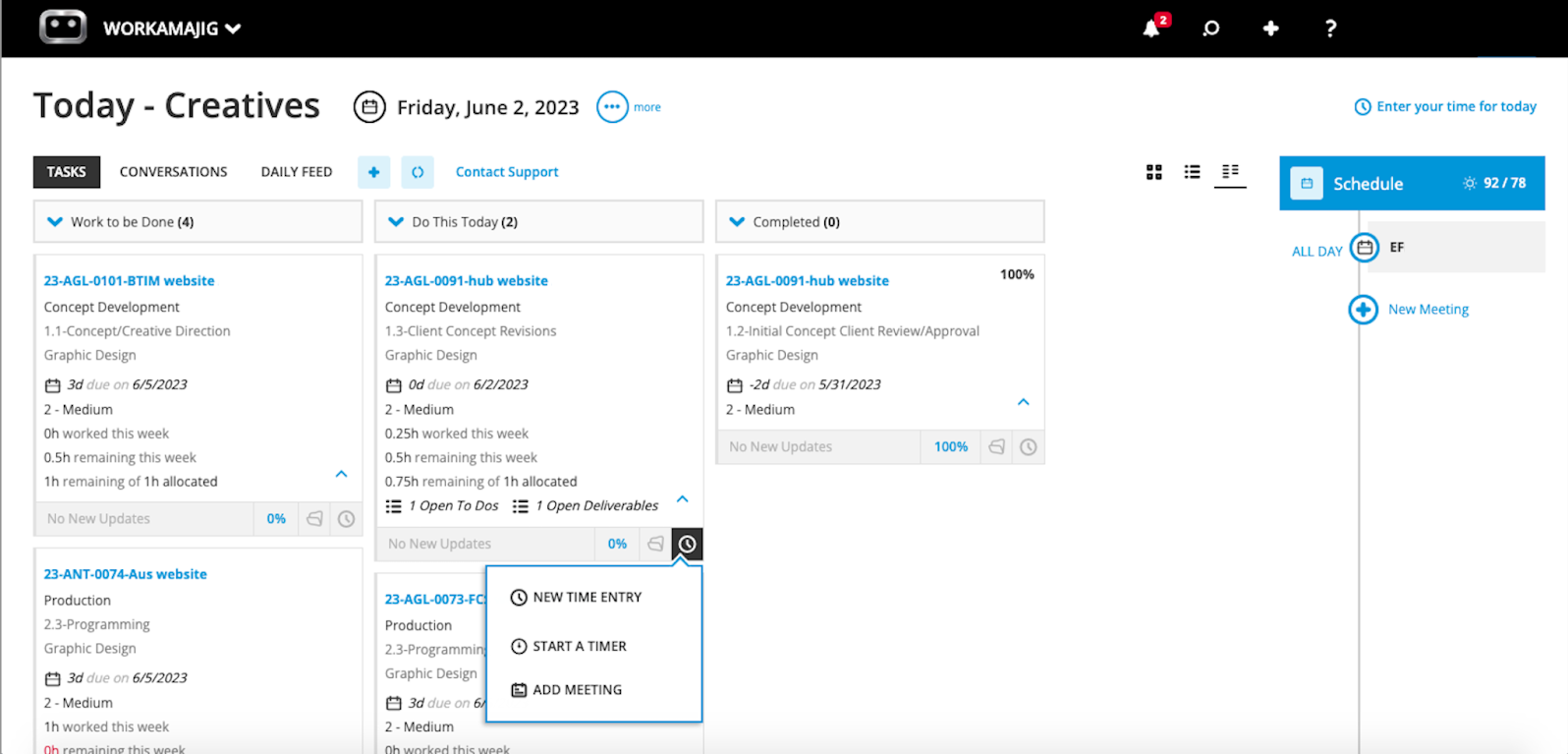
Read more: Top Project Management Tools with Time Tracking (for Creatives)
The Day-to-Day Workflow & Collaborating on Projects
Workamajig provides a “Today” dashboard for all users — showing exactly what to work on to prevent bottlenecks.
Managers can see project requests, vendor invoices, projects that require attention, and all other tasks to complete.
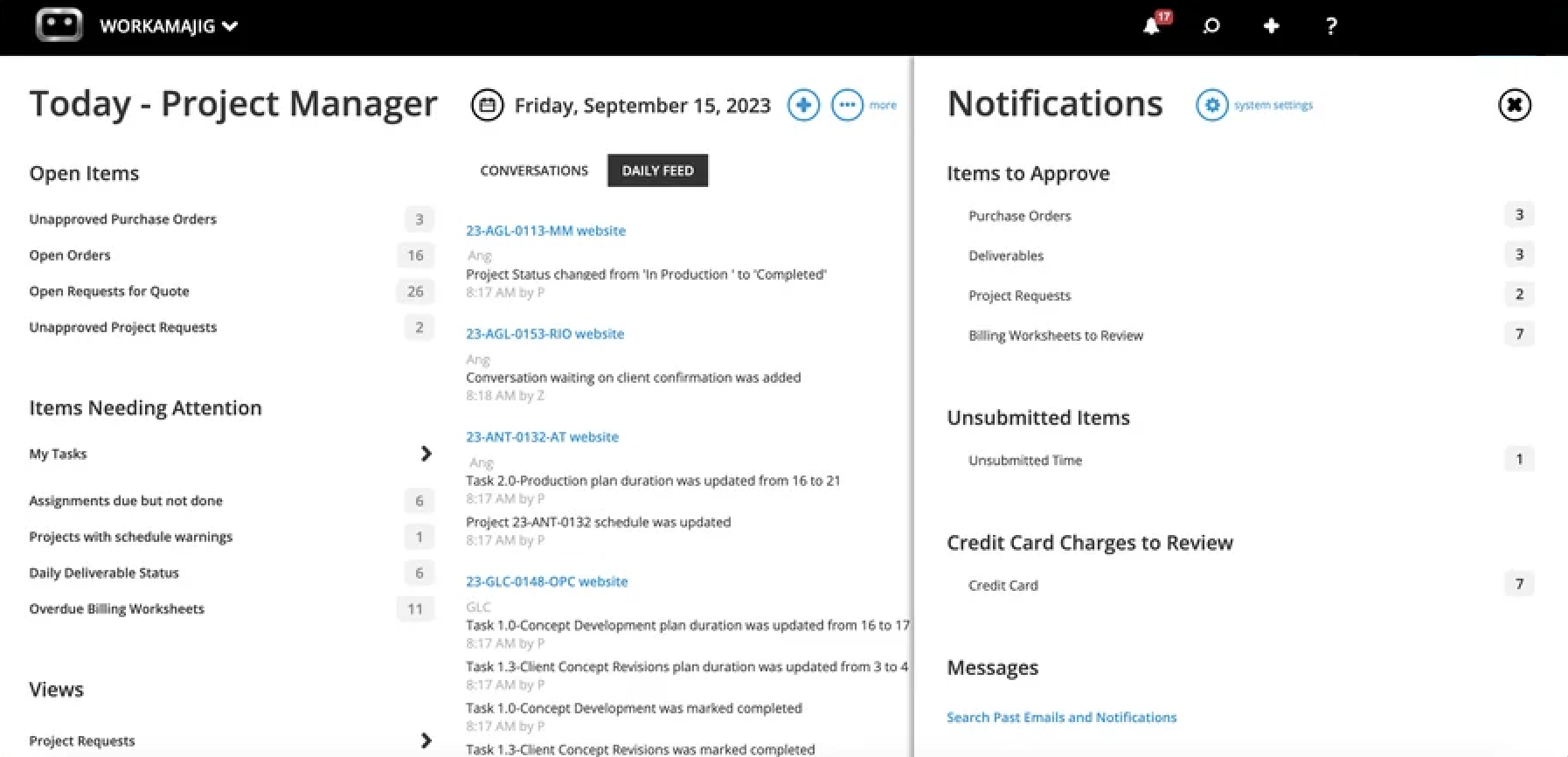
Staff members can see their tasks for the day (and the week ahead) along with all details — what takes priority, how long to spend on tasks, and what’s expected.

Clients and vendors can see tasks that require their attention (e.g., if content requires feedback and invoice and payment statuses).

All creative collaboration happens in the task card, where it’s easily trackable.
- Project teams can see all details from initial conversations and what’s expected to complete work effectively.
- Then, they can upload content and tag others — managers, other team members, and clients — for feedback as they work. Workamajig accepts various media types (images, videos, PDFs, HTML, website links, etc.), so you can centralize project content. You can even organize content into folders to keep task cards clean.
- Workamajig also includes internal proofing tools so others can annotate files and collaborate on revisions. Original designers can see feedback, make changes, and upload new versions for review. Our system keeps a version history for all files (and saves file names if you delete content), so you can track all iterations.
- After the review and approval process, users can mark tasks as complete, and clients can access final deliverables in the system.
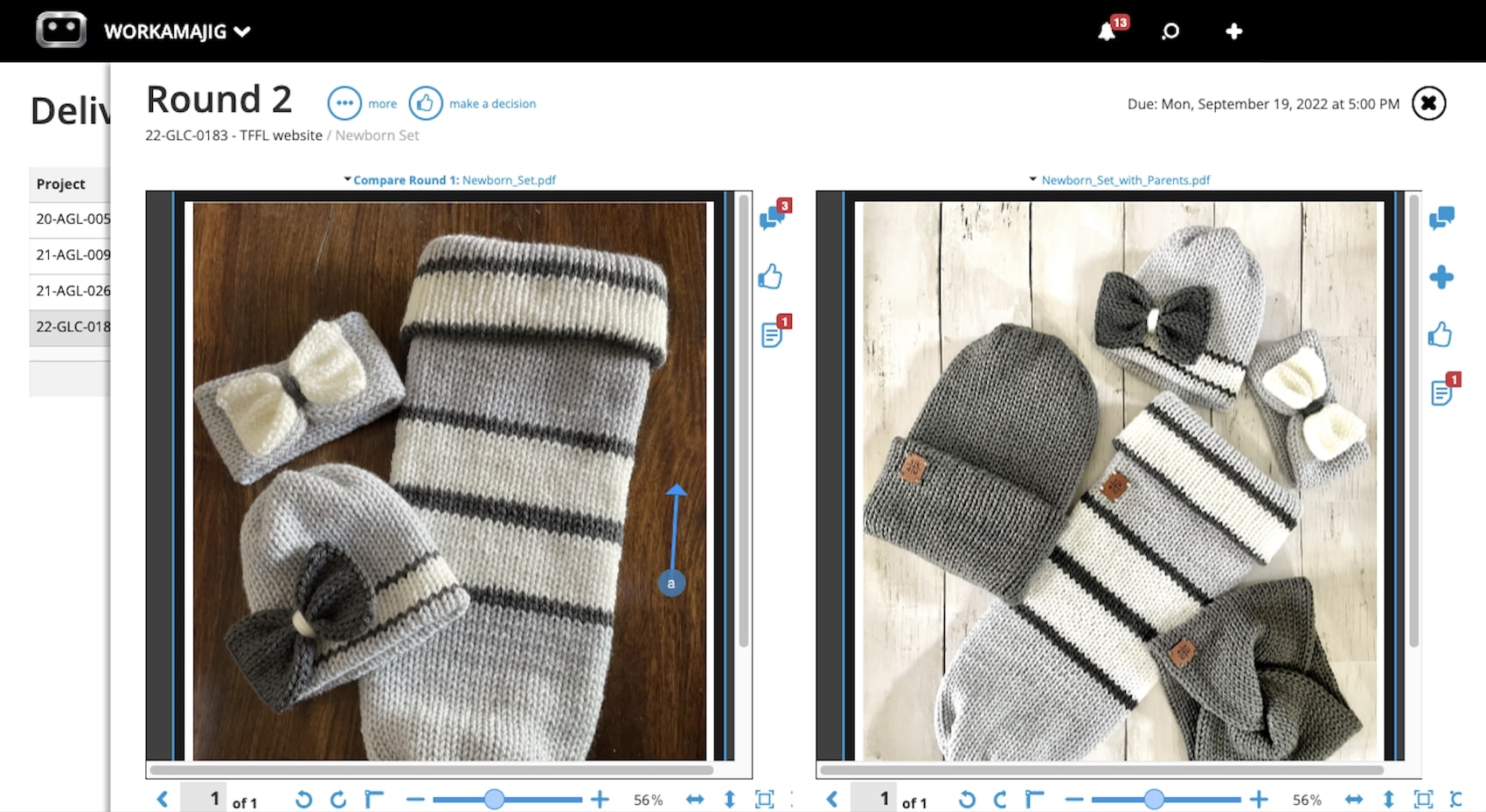
Client Portals
Workamajig lets you create unlimited client portals so that your clients can easily access the system, collaborate with project teams, and track progress. Our portals also let clients generate invoices and send payments.
Note: You can create these portals to manage clients; alternatively, in-house teams may use them to manage work for different departments within their organization.
Billing & Invoicing
Workamajig includes a complete accounting system to support billing & invoicing and help automate this last step.
You can choose your preferred billing method per project (time and materials, fixed fee, media, retainer), and our system will automatically build invoices with all projects’ billable line items.
Clients can automatically generate these invoices through portals, review the details, and send payments. We provide status updates on client invoices so you can see that they’ve received them.

Remember, you can also manage and pay vendor invoices through this system.
You can monitor billing status in our system and track revenue and cash flow with Workamajig’s financial reporting.
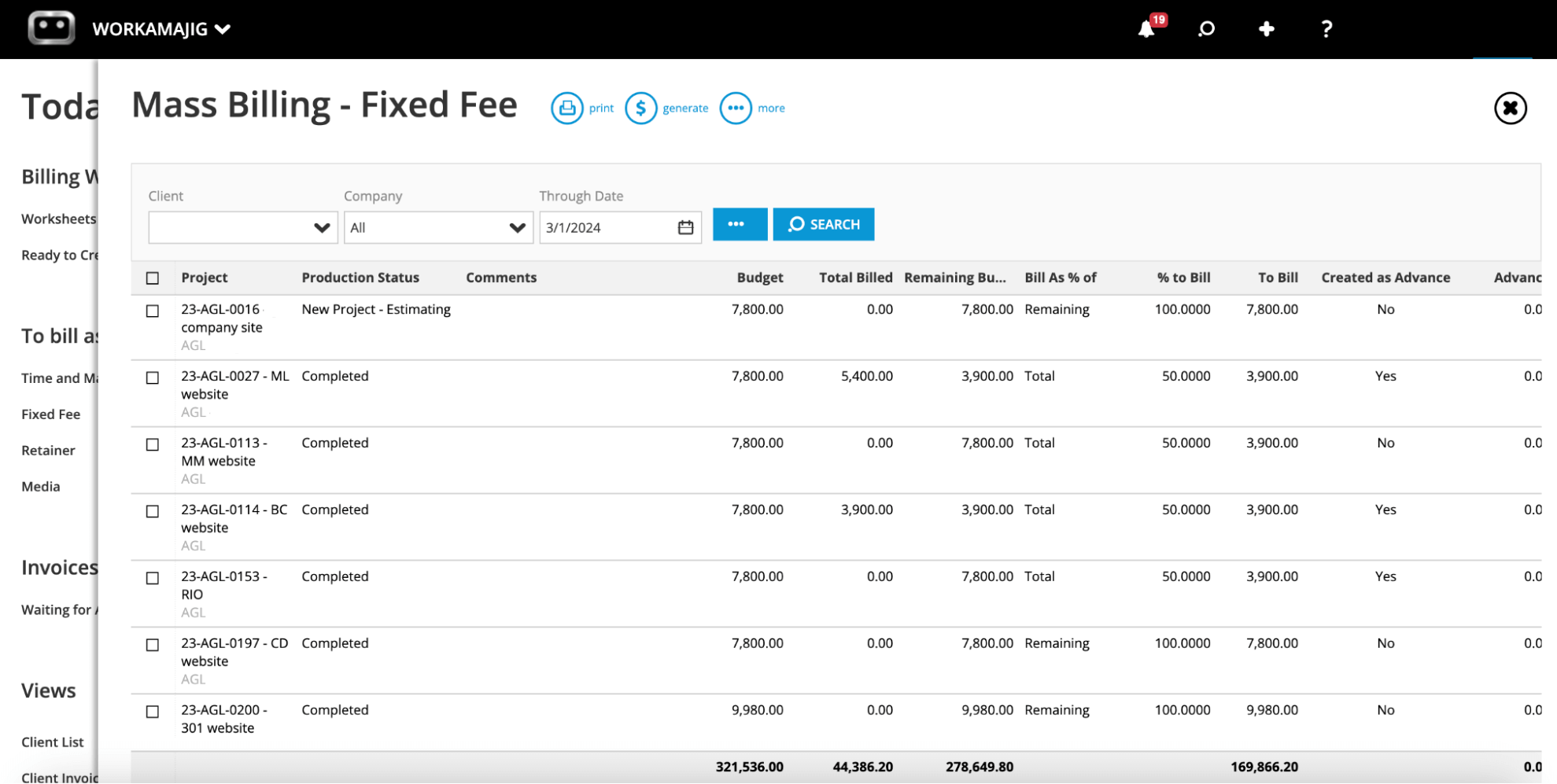
Reporting on Projects
We provide two key ways to report on the success of projects:
- Financial reporting lets you report on actual costs and profits. You can review project details for deeper analysis and use that data for future strategizing.
- Agency Insights lets you see the resources and hours you allocate to projects (aka what employees spend their time on).
Financial Reports
We provide out-of-the-box Profit & Loss reports to see profitability by client.
Our reports are all highly configurable and updated in real-time, so there's no manual work to get the reports and metrics you need.
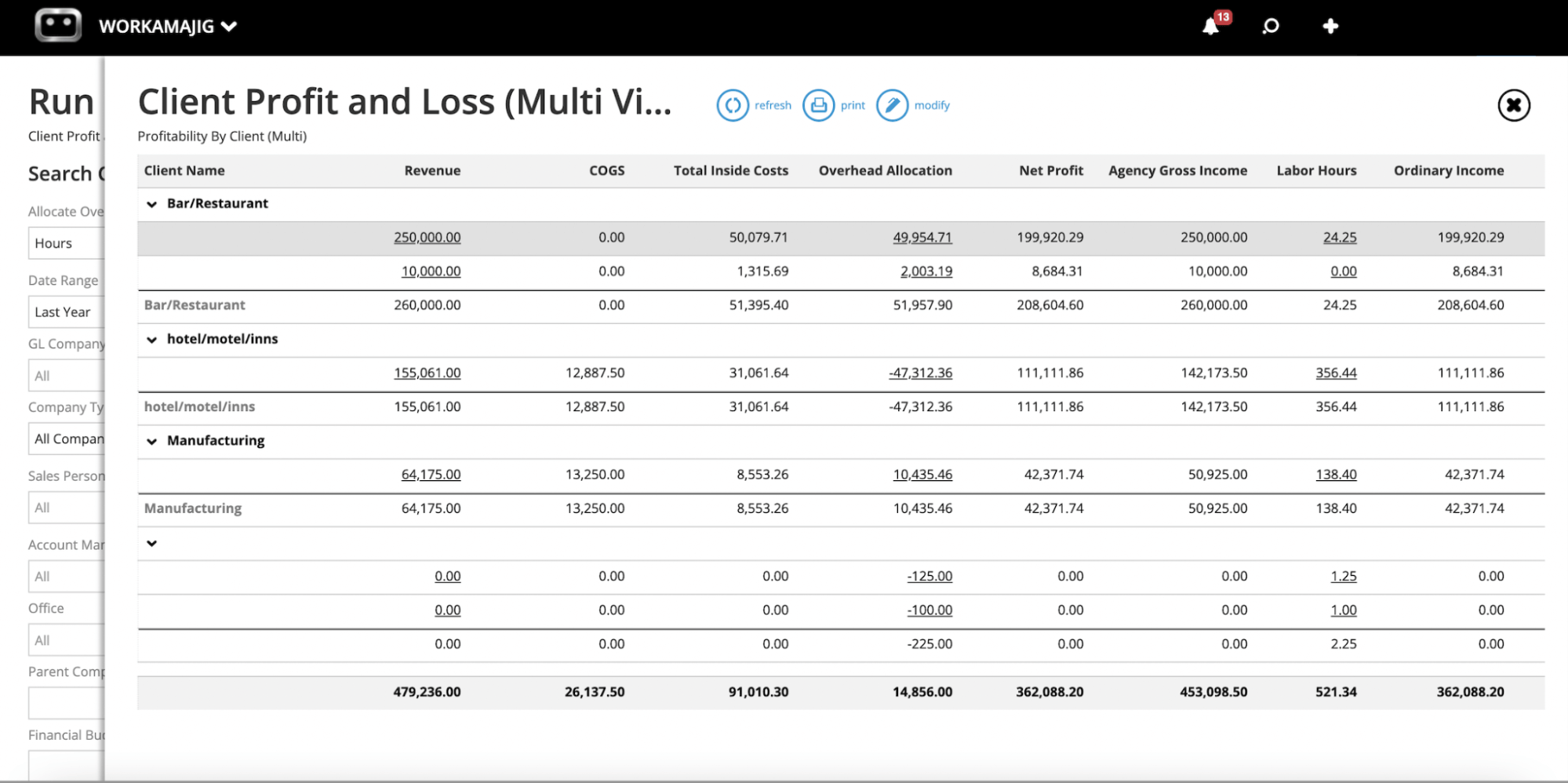
Read more: Best Creative Project Management Software with Financial Tracking
Agency Insights
The Agency Insights dashboard shows hourly reports by client, service, department, and individual. You can see which clients and projects require the most resources and who’s clocking the most time on projects.
Then, you can use this data to guide your strategies.
- Say a client (or department) that eats up a lot of resources is one that consistently sends late or out-of-scope requests; you can work with them on a better feedback process to minimize these and avoid unexpected costs.
- If you see a low-priced service requires a lot of employee hours and doesn’t earn you profit, you could decide to stop offering that service or look at ways to streamline processes and minimize costs.
This dashboard also shows a breakdown of what team members are currently working on and how many hours they’re spending on each task category, so you can get a bird' s-eye view of what’s in motion and jump in where necessary.
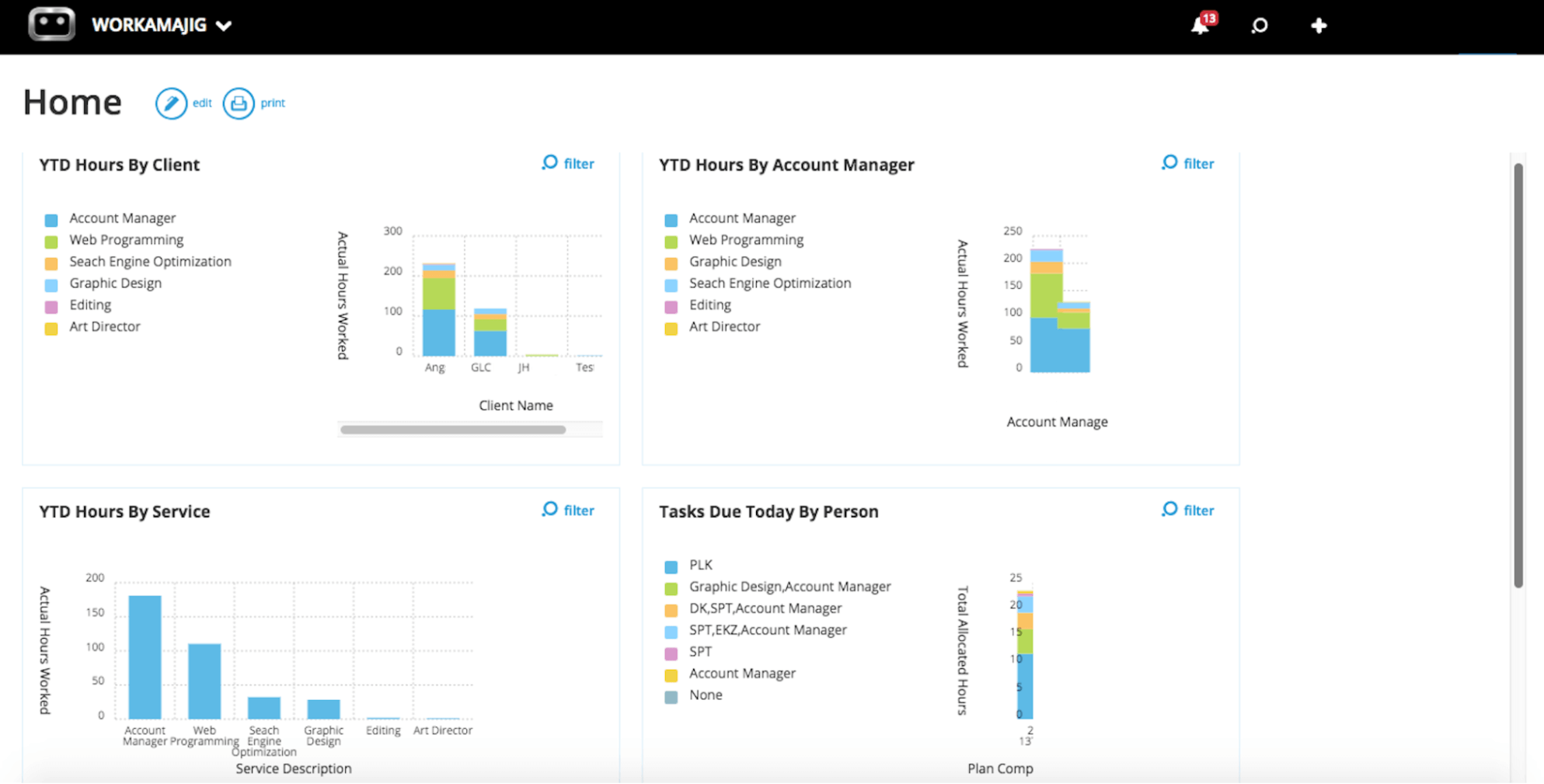
Alternative Creative Workflow Systems
In addition to Workamajig, names like Advantage, Clients & Profits, and Adobe Workfront are popular with creatives and marketers.
We’ve written separate guides reviewing these software tools, where you can read more:
But here’s a list of eight top-rated options with quick summaries:
- Advantage — Enterprise agency management solution includes project management, resource management, media buying, and accounting software.
- Clients & Profits — Agency management solution that combines project management, resource management, and accounting. It also includes media buying integrations.
- Adobe Workfront — Enterprise project management software for teams already embedded in the Adobe ecosystem. This option lacks essential tools like time tracking and financial reporting.
- RoboHead — Customizable creative workflow management software that typically appeals to in-house teams.
- Productive —Project management software with resource management, time tracking, and financial reporting. This tool is app-powered, though, and relies on integrations with accounting software and other tools to support the full creative workflow.
- Teamwork — Like Productive above, Teamwork is a more comprehensive project management software with robust collaboration tools. However, it still relies on apps to support certain functionality. Teamwork primarily appeals to larger brands.
- Scoro — Scoro is another app-powered project management solution for creatives and marketers. It includes resource management, financial forecasting, and reporting. Scoro markets its solution as work management software because it integrates with various other tools to function as a single source of truth.
- Paymo — A recommended solution for small teams; Paymo project management incorporates resource management, time tracking, and budget monitoring — and integrates with other software in your tech stack —to support the creative workflow.
Getting Started
Our team can show you the “Workamajig way” of managing creative projects. Our processes and software support the best practices we discussed above, so you can manage each aspect of creative projects and workflows in our software — and track everything easily in one place.
We offer packages and pricing for in-house teams and agencies of all sizes.
Request your free demo to chat with a member of our team.
Related reads:


